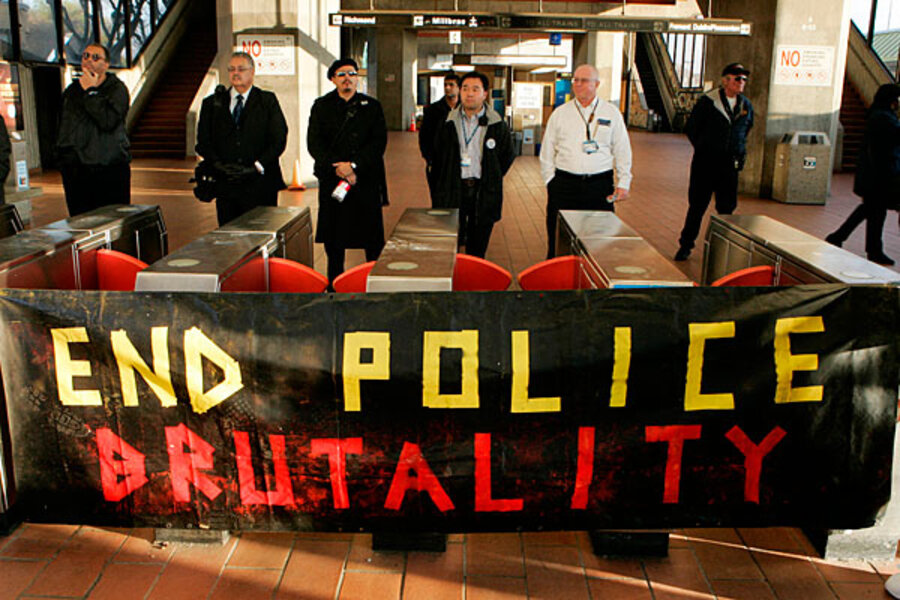Questions abound after fatal shooting is captured by cops' own camera
Loading...
| Los Angeles
A fatal shooting by police in Oakland, Calif., captured on video by a city-issued camera clipped to the officer’s chest, is bringing attention to the growing phenomenon of camera-wearing police in cities across the country.
On Sept. 25, two Oakland police officers pulled over a car and the passenger of the car, who allegedly had a gun and drugs, fled on foot. Video footage from the officer's chest-mounted camera shows a struggle between one of the officers and the fleeing man – and the fatal shot fired from the officer's gun.
The fatal shooting is the first in the Bay Area – and the second nationally – to be captured on video by a practice that has grown to include about 1,100 of the 17,000 police agencies nationwide. The rise of camera-wearing police is the outgrowth of a trend that has grown since the 1991 Rodney King police-beating case: mounting video cameras in police cruisers both to protect officers against allegations of abuse and to promote police accountability.
But for all its benefits, the new technology also raises questions, ranging from how police departments can guard against tampering to whether the videos should ever become public. Experts say the Oakland incident, now under investigation, is an opportunity to bring legal and regulatory clarity to the practice.
“There are a lot of issues floating around about all of this,” says Robert Langran, a constitutional scholar at Villanova University in Pennsylvania. “A lot will depend on the circumstances of each case, what the police want, what the victim’s family wants, whether charges are brought, and whether the case is civil or criminal. If charges are brought, a lot of this will get clarified, if not, much will remain iffy.”
The first police chest-cams were used in 2007, according to VIEVU, a Seattle company that manufactures them. Though only about 6 percent of police agencies use them, some observers say they could become as common as cruiser-mounted cameras in the years ahead.
For its part, Oakland adopted the wearable cameras after Oscar Grant, an unarmed black man, was fatally shot by police on New Year's Day in 2009, leading to protests, says John Burris, an Oakland attorney who specializes in police-misconduct cases. The shooting was caught on video by a bystander using a cellphone.
Advocates who want to see more accountability from their police departments are optimistic about the use of the cameras. “Chest-borne video cameras ... are giving us the objective accountability we have been striving for ever since Rodney King,” says Mary Powers, president of the National Coalition on Police Accountability in Chicago.
But best practices are still emerging. Officers in Oakland are expected to record all stops and arrests and were at first only allowed to watch the footage after filing a preliminary report. But Oakland police officials later decided the officers involved in the shooting should have been able to view the video prior to filing their reports.
It is also unclear how the use of the cameras will be protected from tampering, says Jay Stanley, senior policy analyst for the American Civil Liberties Union.
“These cop cams are being seen more and more around the country, and we think they can be very good as long as there are strict rules on how the video is handled, so that it can’t be edited on the fly,” says Mr. Stanley. “We’re against the government taping random people all the time, but when surveillance is used as a check and balance against the government, it’s a good thing and can help the officers as well.”
Yet video evidence is not a cure-all, say others.
“The tendency is to think that video tape can’t lie,” says Robert Mintz, head of the government investigations and white collar criminal defense practice group for McCarter & English, a law firm in Newark, N.J. “But what this brings up once again are the questions of what happened just prior to the video, and what is happening outside the frame. There are lots of incidents in which videos give a misleading impression of what occurred, and both sides can take advantage of that.”
Moreover, privacy concerns should be paramount. If the videos were ever to become public, there would need to be ways of protecting the rights and safety of individuals caught on tape who have nothing to do with the event.
“It could be dangerous for witnesses to be shown on TV, which could identify them publicly as someone a violent gang should neutralize as a matter of good business practice,” says Joel Jacobsen, assistant attorney general, criminal appeals division for New Mexico. “It also seems like a real invasion of privacy to show the distress of someone who was present at the crime scene only by coincidence and has no desire to be shown on TV in a state of hysterical fear.”
The Oakland Police Department does not make its videos public, but citizens can file public-information requests, just as they would for a police report, spokeswoman Johnna Watson says. She would not discuss the details of the case, but said it was department policy for an officer involved in a shooting to receive three days administrative leave before returning to work. An investigation is ongoing, she added.





